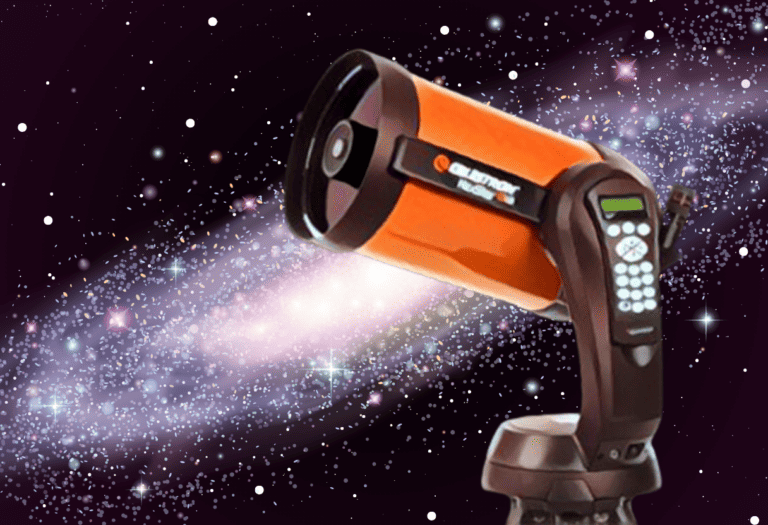Is your passion for stargazing urging you to find the perfect telescope for travel?
Finding a compact telescope that offers both stellar observation capabilities and portability can transform your travel experiences, allowing you to explore the stars from any location.
While the charm of a large, high-power telescope is undeniable, it’s the small, travel-friendly telescopes that let you capture the night sky’s wonders on the go.
Well, we’ll be going over:
- What are the key features to consider when choosing a portable telescope that doesn’t compromise on optical quality?
- How can a beginner effectively balance the need for a user-friendly telescope while ensuring it’s suitable for travel?
- What additional accessories or features should be considered essential for a travel telescope to enhance the stargazing experience?
Embarking on a celestial journey with a travel-friendly telescope offers an extraordinary way to connect with the cosmos, no matter where you are.
Let’s dive in.
Top Travel Telescopes for Stargazing on the Go
- Celestron 80mm Travel Scope – Top Pick
- Celestron Travel Scope 70DX
- ToyerBee Travel Scope
- Celestron 70mm Travel Scope
- Koolpte Travel Scope
I’ve scoured the market to find travel telescopes that combine portability with performance. Whether you’re an amateur stargazer or a seasoned astronomer, this curated list represents the best options for celestial viewing during your adventures. They offer a balance of compact size, ease of use, and excellent optical quality to ensure that you don’t miss a single detail of the night sky, no matter where your travels take you.
Celestron 80mm Travel Scope
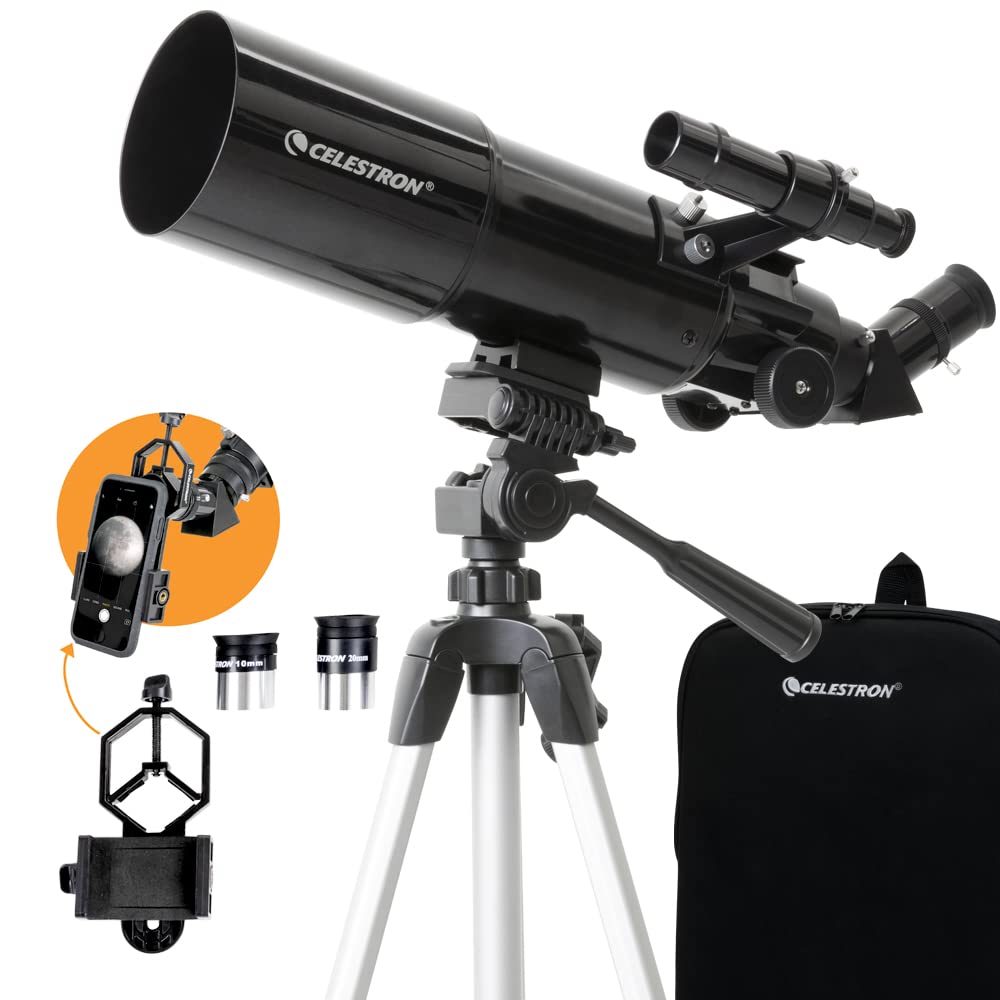
After a few stargazing sessions with the Celestron 80mm Travel Scope, it’s clear this telescope is a fantastic option for beginners looking for a portable and user-friendly way to explore the skies.
Pros
Cons
I recently had the pleasure of using the Celestron Travel Scope while on a camping trip. Its compact size and the custom backpack made it incredibly effortless to transport through the woods to our observation spot. Once there, it wasn’t long before we were gazing upward. The no-tool setup claims held true, and within minutes, the telescope was ready for use. The optics were impressive for such a compact telescope, providing crisp images of the moon’s surface.
One feature I found particularly clever was the smartphone adapter. Attaching my phone was straightforward, and soon enough, I was capturing images of lunar craters and sharing them with friends. The eyepieces included offer different magnifications and are very easy to switch out for diverse viewing experiences.
Despite its many advantages, the tripod’s stability could be an area for improvement, particularly when cantilevering the scope upward. Additionally, while the eyepieces are suitable for starting out, serious stargazers might want to expand their accessory kit for deeper sky exploration. To follow objects across the sky, it takes some practice due to the manual controls, which can be tricky to master for smooth tracking at higher magnifications.
In conclusion, as someone who values the simplicity and clarity of viewing that blend with the convenience of portability, I found the Celestron Travel Scope to be a suitable companion. It’s well-suited for novices and those who appreciate the ease of a grab-and-go telescope, although it might leave the more ambitious amateur astronomers yearning for more advanced features.
Celestron Travel Scope 70DX
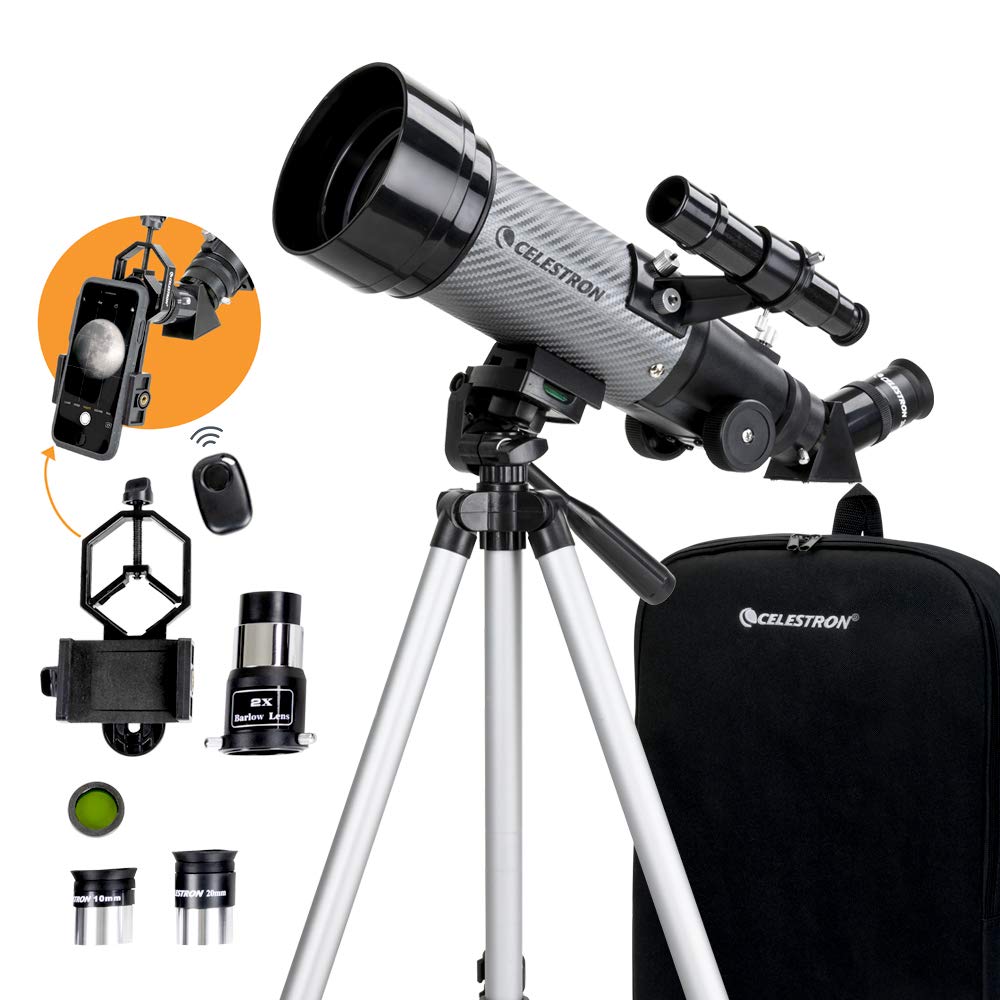
Having tested this telescope personally, I can confidently say the Celestron Travel Scope 70DX is a solid choice for anyone seeking an affordable, portable, and user-friendly option for exploring the cosmos and nature.
Pros
Cons
In my time using the Celestron Travel Scope 70DX, I’ve found it to be a remarkably versatile instrument. Whether I was chasing celestial wonders or scouting the picturesque landscape, the scope’s coated glass optics delivered bright and detailed views. Setting it up under the night sky, I was particularly impressed with how the moons of Jupiter came into sharp focus, and the craters on our Moon stood out in stark relief.
The scope’s ease of use is another feature that stood out to me. As a seasoned stargazer, I appreciated the simple design that wouldn’t intimidate a novice. The convenience of two eyepieces permits a quick switch between wide field and zoomed views, an aspect I found handy when I switched from panoramic stargazing to targeted observations of Saturn’s rings.
The cherry on top is the digiscoping smartphone adapter. Snapping onto the eyepiece with ease, I connected my phone and captured crisp shots of a crescent Venus. The Bluetooth shutter release allowed me to take pictures without jostling the setup, which is crucial when you’re dealing with such high magnification.
However, the lightweight tripod is something of a double-edged sword. Its portability is fantastic, but I noticed it can wobble, especially in breezy conditions. While focusing, a steady hand is required to avoid losing your target, a skill that new users will have to develop over time.
All things considered, this telescope has been a joy to use. It’s easy to carry on adventures, simple for beginners to get the hang of, and comes packed with features that make it easy to capture and share your observations. Despite a few imperfections, it’s a splendid piece for casual and budding astronomers alike.
ToyerBee Travel Scope
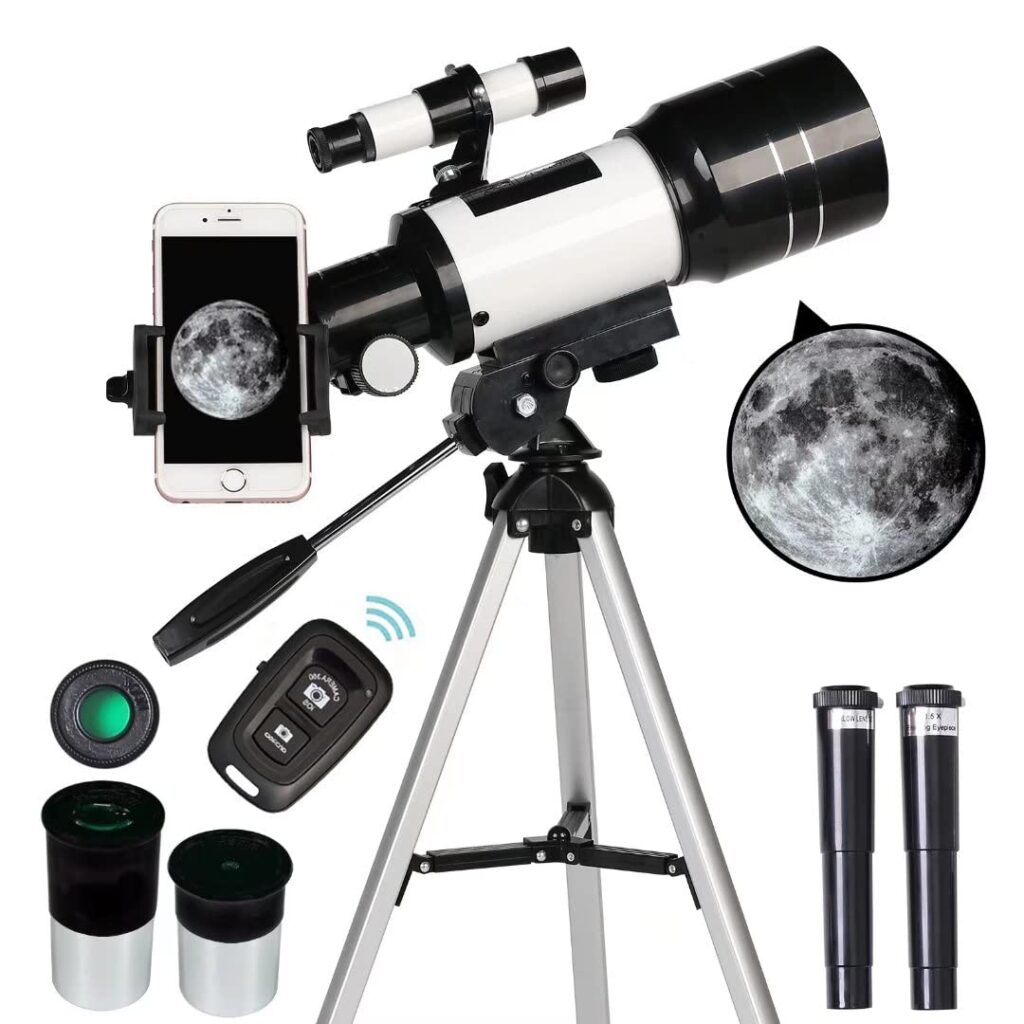
Taking this telescope out to the field, I was struck by how well it blended portability with rewarding views, making it an optimal choice for anyone just starting their astronomy hobby.
Pros
Cons
During a recent camping trip, I had the pleasure of using ToyerBee’s Travel Scope. Its ease of assembly was remarkable, and I didn’t need any tools or an extra hand. Despite its small size, I found that I could easily pack it along with my other gear.
The scope’s lightweight design was a blessing on my night-time treks into the wilderness. I also appreciated the large, clear images the 70mm aperture provided. Peering up at the cosmos, the stars and planets appeared bright and focused.
One more feature I enjoyed was connecting my phone with the telescope’s adapter, which allowed me to capture some amazing celestial sights. Those snapshots are now among my favorites and are a great way to share my experience with friends and family.
Celestron 70mm Travel Scope
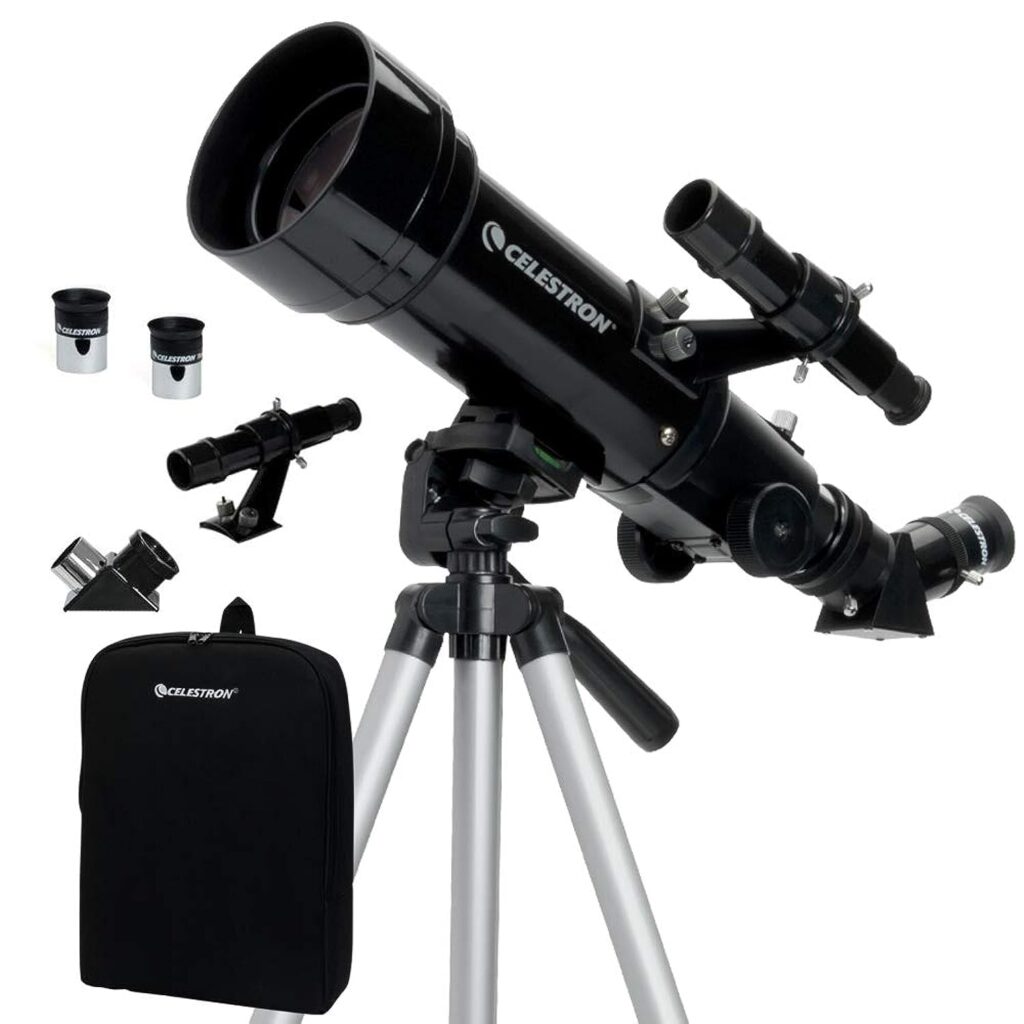
I found the Celestron 70mm Travel Scope to be an excellent choice for anyone seeking a portable and easy-to-use telescope for both celestial and terrestrial viewing.
Pros
Cons
With the Celestron Travel Scope, my stargazing adventures have become a lot more spontaneous. Its lightweight frame and backpack make it a breeze to transport, whether I’m heading out to the countryside or just setting up in my backyard. The glass optics are fully-coated, a feature I definitely appreciate when I observe the moon’s craters in sharp detail.
I had a great experience using the two eyepieces included. They provide different levels of magnification, which makes this telescope versatile for viewing a wide range of celestial objects. Whether it’s spotting the rings of Saturn or just watching birds in the distance, the views are bright and clear.
What I like most is how simple it is to set up; it literally takes just a few seconds, and no tools are needed. This makes it approachable even for beginners or children. Although I find the tripod could be more solid as it wobbles a bit during use, it is fully functional for a quick gaze at the stars or terrestrial viewing.
In summary, if you’re considering a telescope that balances portability with functionality, the Celestron 70mm Travel Scope should be on your list. It won’t replace a large, stationary telescope for deep-sky viewing, but it’s not meant to. Instead, it’s perfect for travel, quick viewing sessions, and as an entry into the world of astronomy.
Koolpte Travel Scope
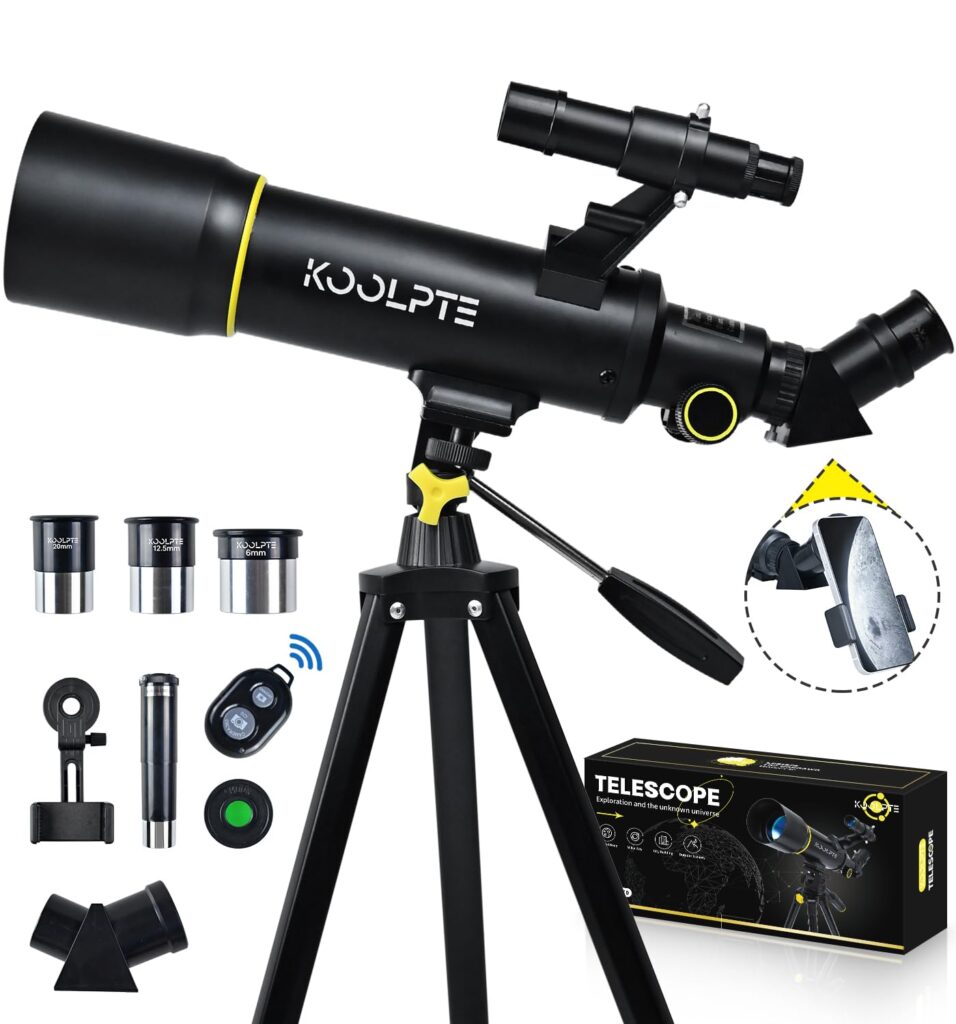
If you’re on the lookout for a telescope that complements your travel adventures with celestial observations, the Koolpte Travel Scope is definitely a gem to consider.
Pros
Cons
I recently had the opportunity to take the Koolpte Travel Scope on a stargazing expedition, and it made the experience considerably memorable. The optical clarity took me by surprise; it was akin to having a personal window to the cosmos, crystal-clear and rich in detail. Not only does this telescope boast a generous aperture that bathes in starlight, but its lenses also stay pristine thanks to the scratch-resistant coatings.
What stood out for me was the sheer versatility of the telescope. With its multiple eyepieces and a durable Barlow lens, I reveled in the different magnification options, one moment patrolling the craters of the moon, the next zooming out to greet the Andromeda Galaxy. The portability is a real plus – the telescope is unexpectedly light, making it a breeze to carry around on rugged trails or when I’m limited on packing space.
On the flip side, the initial setup took me a bit longer than anticipated. The instructions could be more intuitive, which is something to keep in mind if you’re a novice star seeker. Moreover, while the lightweight tripod grants easy portability, it might not fare well in windier situations, where a sturdy stance is key. It’s a trade-off that’s worth considering depending on where you’re headed.
The Koolpte Travel Scope was a great travel companion, making stargazing accessible and enjoyable. Perfect for those who value optical quality and compactness, this scope gives a nudge to every traveler to start looking up.
Buying Guide
When selecting the best telescope for travel, I consider portability, weight, and optical quality. Telescopes need to be lightweight and compact enough to carry easily, but without compromising on the clarity and sharpness of the images they produce.
Size and Portability
I look for a telescope with a retractable or collapsible design, making it easy to pack. The mount should also be sturdy yet lightweight. Tabletop models are often a good choice for travel.
- Aperture: Small to moderate aperture is sufficient; larger apertures are bulkier.
- Design: Preferably a refractor or a compact compound telescope.
Optical Quality
Good optics are essential, but when traveling, the perfect balance between lens/mirror quality and portability is key.
- Lens Coating: I check for fully-coated optics to enhance image brightness.
- Focal Length: A longer focal length can provide more detailed views but may add to the size.
Ease of Use
It should be easy to set up and use, as I’ll possibly be using it in remote locations or on the move.
- Mount Type: A simple altazimuth mount is adequate for casual stargazing.
- Finder Scope: A red dot or a finderscope that’s easy to align is preferable.
Durability
Since my telescope will face various transport conditions, durability is important.
- Materials: I ensure the body and the mount are made of robust materials.
- Protection: A hard or padded case is beneficial for protection during travel.
Additional Features
Extra features can enhance the stargazing experience.
- Eyepieces: A scope with at least one quality eyepiece.
- Accessories: A built-in compass or GPS can be helpful for star navigation.
Frequently Asked Questions
Choosing the right travel telescope involves understanding key specifications, ease of use for beginners, and recognizing the best options for both portability and high-quality observations.
What specifications should I look for in a travel telescope for astrophotography?
For astrophotography, I look for telescopes with a sturdy mount, precise tracking capabilities, and a fast optical system (low f/ratio). A good travel telescope will also have a DSLR adapter and be lightweight for easy transport.
How can beginners choose a suitable travel telescope?
Beginners should find telescopes that are easy to set up and use. I recommend a telescope with a user-friendly design, such as a refractor or a tabletop Dobsonian, which offer excellent stability and require minimal maintenance.
What are the recommended portable telescopes for detailed planetary observations?
When focusing on planetary details, I opt for telescopes with high optical quality and magnification. Maksutov-Cassegrain telescopes strike a good balance as they are compact, have long focal lengths, and offer sharp images.
What are the key features to consider when selecting a travel telescope for stargazing?
For stargazing, portability, and ease of use are paramount. I seek out a telescope with a wide aperture to gather more light, a reliable mount, and one that offers a hassle-free setup to enjoy the night sky quickly.
How do Celestron Telescopes compare to other brands for travel and portability?
Celestron telescopes are highly competitive, often featuring portable designs like the NexStar Evolution series. These models are renowned for their quality optics, built-in WiFi, and rechargeable batteries, which make them convenient for travel.
What are the most compact telescopes for convenient travel without compromising quality?
I prioritize telescopes like refractors and Schmidt-Cassegrains for their compact designs. Brands like Celestron and SkyWatcher offer some of the best options that maintain optical excellence in a travel-friendly size.






